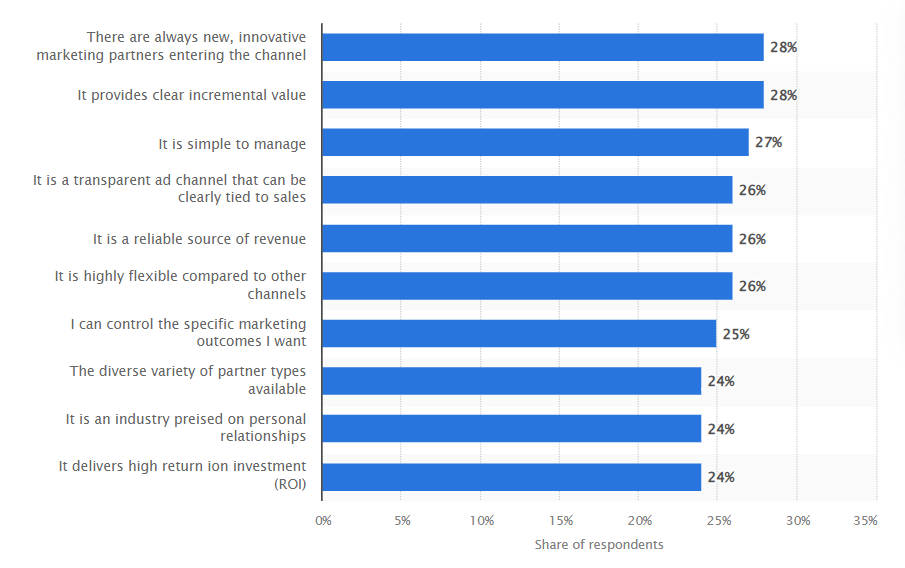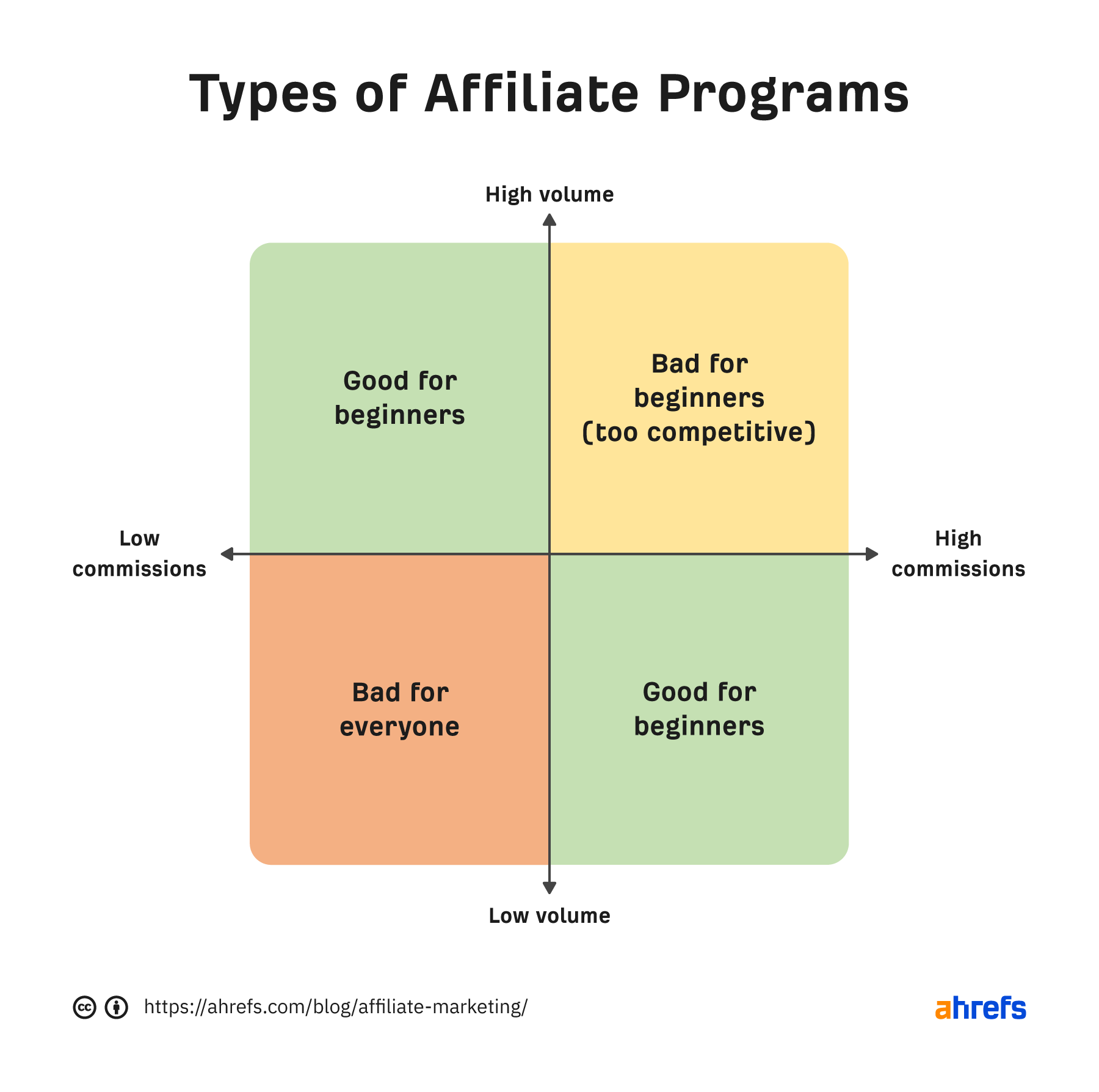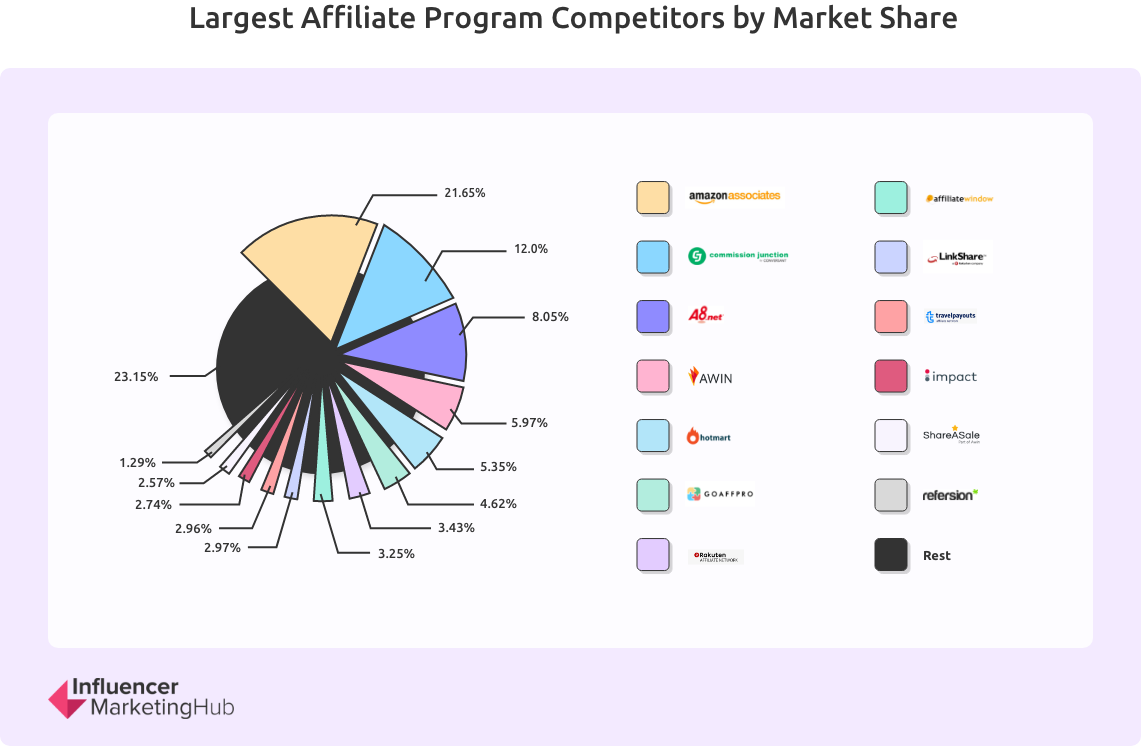How to Choose the Right Affiliate Program: Ultimate Guide

Affiliate Program Success: Top Strategies for Smart Selection
Choosing the right affiliate program can be the difference between a trickle of income and a lucrative revenue stream. With the affiliate marketing industry expected to reach $12 billion by 2025, getting it right is more crucial than ever. But how do you ensure you pick a program that sets you up for success?
Critical advantages of affiliate marketing, as identified by marketers globally in January 2024, are:

Source: Statista
You can confidently choose an affiliate program that aligns with your goals and maximizes your earnings first. According to 42.9% of marketers, affiliate marketing brings more revenue than ad monetization. However, the most profitable program isn’t necessarily the one with the highest commission — it’s the one that best suits your business. If you want to choose an affiliate program worth its weight in gold, delve deeper and make a well-informed decision.
Source: GIPHY
What Makes an Affiliate Program Perfect?
Affiliate marketing accounts for 16% of all internet orders in the U.S., and 81% of brands use affiliate programs to elevate their visibility and drive sales. This scale illustrates just how crucial affiliate campaigns are for boosting revenue and making your brand stand out.
Your primary focus should be selecting affiliate programs that resonate with your personal brand or business objectives and align with the niche you’re targeting. Though it takes time, doing so can simplify expanding your audience and amplifying your reach.

Source: Ahrefs
While there’s no universal formula for the ideal affiliate program, the most effective ones share specific attributes:
- They promote products with proven success and offer attractive commission structures, including high rates and recurring commissions that reward repeat customers.
- A longer cookie duration increases your chances of earning from delayed purchases.
- Transparency in terms and conditions and user-friendly tracking tools are vital in providing clarity and efficiency.
How to Look for Affiliate Programs: Top 7 Sources
Affiliate marketers know that finding the right programs can be both exhilarating and daunting. But once you’re there, you reap significant benefits: high commissions, excellent conversions, and a stronger connection with the audience.
To ensure you’re aligning with opportunities that maximize your revenue and resonate with your audience, here’s a business-savvy guide to pinpointing the ideal affiliate programs:
- Google search: Affiliate marketers can start with a simple Google search. For instance, use specific and niche-related keywords, such as “best affiliate programs for health insurance” or “top-paying affiliate programs.” This basic but effective method often uncovers well-established programs and hidden gems that may not surface through other channels.
- Competitor analysis: Investigate affiliate offerings promoted by your competitors to see the whole scene. Analyze their content and look for affiliate links or promotional partnerships. You can use tools like SEMrush or Ahrefs to uncover the programs your competitors are affiliated with, offering insights into potentially lucrative options.
- Affiliate directories: Leverage affiliate directories to discover a wide range of programs. These directories offer comprehensive details on various affiliate opportunities, including commission structures, payment terms, and program reputations. A thorough search in these directories can reveal popular and niche programs that merit your consideration.
- Social media trends: Social media is a goldmine for discovering trending products and services. You can spot popular affiliate programs if you constantly monitor hashtags, follow influencers, and join niche groups. Platforms such as Instagram, LinkedIn, and X often feature affiliate partnerships that are gaining traction.
- Audience feedback: Your audience is an invaluable source of insights, referrals, and inspiration that guide your decisions. Engage with them through surveys, polls, or feedback forms to learn about their preferences and interests. By aligning your affiliate programs with their needs, you can drive higher engagement and boost conversions.
- Google Trends: To shape more effective affiliate strategies, use Google Trends to see which products or services are currently in demand. You can identify which affiliate programs align with current market interests and consumer behavior by analyzing search trends and seasonal patterns.
- Research online categories: Dive into online categories and directories that list diverse affiliate programs. Websites like CJ Affiliate and ShareASale categorize programs by niche, making it easier to find ones that align with your audience’s interests.
- Products you used: Reflect on products or services you’ve used and enjoyed. Promoting these products as an affiliate can enhance your credibility and authenticity if you’re already a satisfied customer. Your genuine experience can resonate more deeply with your audience, often leading to better results.
In 2024, SaaS products offer the highest commissions, while the Toy and Home & Garden niches are experiencing a surge in popularity. Among the other four most profitable sectors are:
- Education/E-learning
- Finance & Banking
- Insurance
- Solar
- Travel
- HVAC
- Beauty & Skincare
For instance, affiliate marketers in the education and eLearning niche earn an impressive average monthly income of $15,551.
Selecting Affiliate Marketing Programs: 5 Key Criteria
1. Understand Your Niche
- Relevance is key: 81% of marketers and 84% of publishers leverage the power of affiliate marketing as a key part of their strategies. However, real success comes to those who carefully align their affiliate programs with their specific niche.
2. Evaluate Commission Rates
- High-ticket items: Look for programs offering commissions on high-ticket items. The most profitable ones provide between 15% to 30% commission rates. With 30% of affiliate marketers earning $20,000+ annually, a higher commission rate can fast-track your success. For instance, affiliate marketers in the finance niche earn an impressive average monthly income of $9,296.
3. Check the Conversion Rate
- Performance matters: A program with a higher conversion rate means more earnings. Top-performing affiliate programs often have conversion rates between 5% to 15%. Here’s a simple rule — the higher, the better. You can earn more money by choosing those with proven track records.
4. Consider the Cookie Duration
- Maximize your earnings: The industry standard cookie duration is 30 days, but some programs may provide 60 to 90 days. Longer durations increase the likelihood of earning commissions from delayed purchases.
5. Assess the Support and Resources
- Tools for success: Programs that offer comprehensive marketing materials, training, and dedicated support can significantly boost your chances of prosperity within the niche. With 40% of affiliates saying better support is critical to their success, choosing a program with solid resources can make a big difference.
How to Choose the Right Affiliate Program
When selecting the most suitable affiliate program for your business, evaluate more than just assessing commission rates and cookie durations. It’s crucial to examine various aspects thoroughly.

Source: InfluencerMarketingHub
Here’s a step-by-step guide to help you make a thoughtful decision:
Research the Product or Service
- Check the company’s website: Initiate research and delve into the company’s website to comprehensively understand the product’s features, benefits, and target demographics. Look for customer reviews or testimonials to assess the product’s overall quality.
- Search online: Use search engines and social media to gather diverse opinions about the product. Analyzing reviews and feedback from existing customers can provide insights into the product’s reputation.
- Compare with others: Analyze similar products or services offered by other companies. This comparative analysis helps you determine the product’s market value and positioning relative to its peers.
- Try the product personally: If feasible, experience the product firsthand. This personal evaluation provides a basis for offering genuine recommendations to your audience.
Evaluate the Commission Rate
- Competitive rates: Seek programs offering commission rates that are competitive within the industry and reflect the product’s value. Rates should reflect this value and align with market standards.
- High commission rates: While attractive, high commission rates should not come at the expense of product quality or support. Verify that the program maintains a balance.
- Recurring commissions: Programs offering recurring commissions for subscriptions or renewals can provide a reliable and ongoing income stream, improving your potential in the long run.
- Volume-based commissions: Look for affiliate programs with tiered commission structures based on sales volume, which can reward you for high performance with increased earnings.
- Bonuses and incentives: Programs offering bonuses for reaching milestones or referring other affiliates can enhance your overall earnings as an affiliate.
Check the Cookie Duration
- Length of time: Prefer affiliate programs with extended cookie durations, allowing users more time to complete their purchase and still ensure you earn a commission. It’s essential for products with longer sales cycles as well.
- Type of product: For products requiring more time to finalize a purchase, longer cookie durations are essential. This helps capture sales that may not occur immediately.
- Repeat purchases: Longer cookie durations benefit products with subscription models or those that encourage repeat purchase opportunities.
- Device tracking: Choose affiliate programs that offer cross-device tracking that can help monitor sales across multiple devices and increase your chances of earning commissions.
Evaluate the Affiliate Program’s Reputation
- Affiliate reviews and feedback: Investigate reviews and feedback from other affiliates to gauge their experiences and satisfaction with the program.
- Payment terms: Confirm that the program has reliable and transparent payment processes to ensure timely and accurate compensation.
- Support: Opt for programs with responsive affiliate managers or support teams.
- Brand credibility: Partner with well-regarded brands to enhance your reputation and increase your sales potential.
- Industry associations: Verify if the program is associated with industry organizations, as this affiliation adds an extra layer of trustworthiness.
Look at the Promotional Materials
- Quality and range: Evaluate the quality and variety of promotional materials provided. Professional, varied materials can help enhance your marketing efforts.
- Customization: Check if you can personalize materials with your own branding to resonate with the audience.
- Compliance: Ensure that all materials adhere to legal and regulatory guidelines to avoid any issues.
- Tracking: Confirm that the program offers practical tracking tools to monitor your performance and earnings.
Consider Your Audience
- Relevance: Choose products or services that are a good fit for your audience’s interests and needs, increasing your chances of making sales and earning commissions.
- Quality: Ensure the product maintains high standards to uphold credibility with your audience.
- Price point: Evaluate whether the product’s price point suits your audience to encourage conversions.
- Demographics: Consider your audience’s demographics to ensure the product matches their profile.
- Ethical considerations: Promote products that align with your values to maintain trust with your audience.
Choosing the right affiliate program is crucial in building a successful affiliate marketing strategy. It’s essential to take the time to research and consider each factor carefully. Rushing into a partnership without due diligence can waste time, effort, and resources. By taking a thoughtful and strategic approach to choosing affiliate partners, you can increase your chances of success and achieve your affiliate marketing goals.
Common Pitfalls of Affiliate Programs and How to Avoid Them
Affiliate marketing offers great potential, but there are pitfalls to watch out for. One fundamental mistake is focusing solely on high commission rates. It’s crucial to choose programs that align with your audience and offer quality products. Ignoring the fine print in affiliate agreements can also lead to unexpected issues, so carefully review terms like payment schedules and cookie durations.
Lack of support from an affiliate program can hinder your success. Opt for programs that provide solid marketing resources and responsive support. Additionally, promoting products you haven’t tested can damage your credibility, so test or review products before endorsing them.
Tracking performance metrics is essential for optimizing your strategy. Use the tracking tools provided to monitor your results and make adjustments. Also, ensure that the products you promote align with your audience’s interests to avoid poor engagement.
Finally, managing too many programs can take time and effort. To maintain effectiveness, focus on a few that fit well with your niche and audience. You can set yourself up for affiliate marketing success by avoiding these common pitfalls.
Making the Right Choice For Your Affiliate Success
Choosing the right affiliate program is crucial for your success. Evaluate commission rates, product fit, and company reputation to find affiliate partners that align with your goals. Diversify your partnerships and streamline tracking to boost earnings and optimize your affiliate strategy. Stay informed, stay organized, and watch your affiliate income grow.
Unlock your affiliate marketing potential with Zero Parallel’s Open Market. Our platform offers advertisers a dynamic environment for accessing high-quality leads, connecting with potential clients, and streamlining lead distribution. Boost your revenue and elevate your campaign performance with Zero Parallel.
Join Zero Parallel as an affiliate or advertiser to expand your marketing opportunities and increase your bottom line.
Frequently Asked Questions
How to choose an affiliate program
To select the best affiliate marketing program for your needs, consider the following criteria:
- Commission rates
- Product relevance
- Company reputation
- Support services
What types of affiliate programs are best for beginners?
If you’re new to affiliate marketing, you must focus on user-friendly programs with straightforward terms, reliable tracking systems, and good educational resources.
Can I join multiple programs at the same time?
Yes, you can join multiple affiliate programs at once. Many affiliate marketers diversify their partnerships to maximize earning potential and reduce reliance on a single income stream.
Pros:
- Diversified income
- Broader audience
- Increased flexibility
Cons:
- Management complexity
- Brand dilution
- Overloaded performance tracking
How can I track my progress in an affiliate program?
Track your progress using the affiliate program’s dashboard, which shows metrics like clicks, conversions, and earnings. You can create unique tracking IDs for different campaigns to see which performs best.



